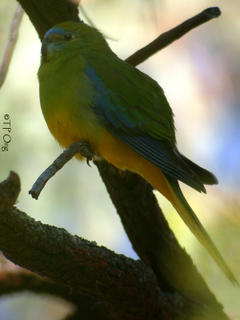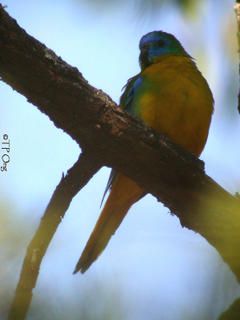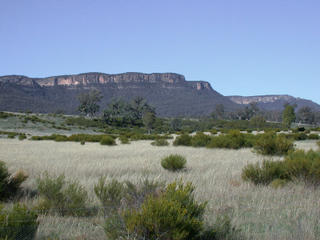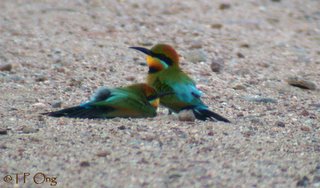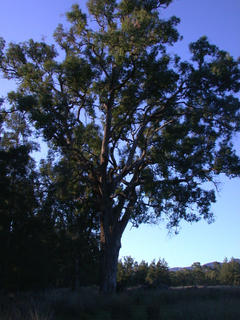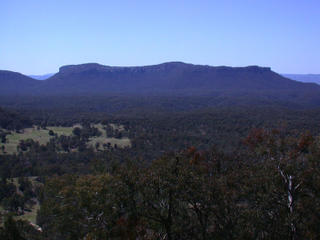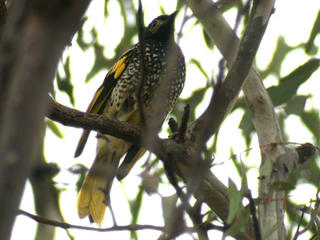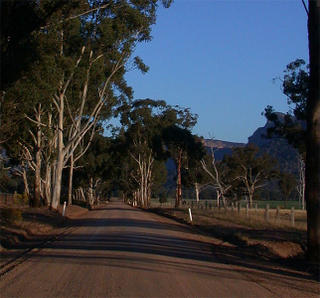
Besides the bad news with Regent Honeyeater, there was not any Swift Parrot seen either. The site where Swift Parrots were abundant about 3 weeks ago was now replaced by Musk Lorikeets and a small number of Little Lorikeets.
The White-plumed Honeyeater seems to do well in this breeding season. This fledging perched only one foot above the ground, about 5 meters away from the road. I was first alerted by the noisy parents as I had accidently stumbled too close to the fledging. As soon as I realised I was too close for the parents' comfort, I quickly stepped back and observed from a distance. Slowly, I followed the movement of the parents and soon then started feeding the fledging. This fledging actually stood out among the darker twigs. However it is not easy to spot it as the fledging remained motionless (did not even blink) most of the time, except when being fed by its parent.
On other sites, there seems to be alot of White-plumed Honeyeaters in gr

oup of 4 or five (Some may be juveniles). This is the most abundant and probably the most successful honeyeater in Capertee Valley.
How badly I wish I had witnessed Regent Honeyeater breeding successfully like this.
Breeding is not just confined to birds in Capertee but also for the Kangaroo. This is my first photo of the marsupial sharing pastures with the cattles. I only discovered after examining the photos at home, that the kangaroo actually had a joey in her pouch!! See inset photo on the right.



This is an
Olive-backed Oriole. A lonely vocal bird in the woodlands. This is my first time recording this oriole in this trip. It is probably a migrant from the north turning up in this woodlands in spring time.

These two
Rainbow Bee-eaters are probably also sping visitors. It seems like the bird on the top is a male as it has longer central tail feather.
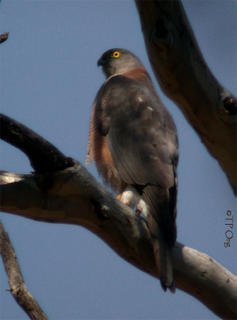 It is always hard to see raptor on perch. This is a Collared Sparrowhawk. It looks very similar to slightly larger Brown Goshawk.
It is always hard to see raptor on perch. This is a Collared Sparrowhawk. It looks very similar to slightly larger Brown Goshawk.This is a 'bird-eating' raptor. However, the aggressive Noisy Friarbird is not its target, I think. The friarbird in fact stayed close with the sparrowhawk. When the sparrowhawk flew away, it looked as if it was being escorted by several Noisy Friarbirds.
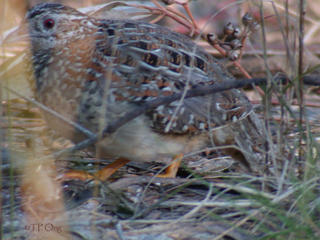
Seeing a very elusive terrestial bird like this
Painted Button-Quail must be a bonus, especially I did not expect to see one, let along to photograph one! This is probably a male and it has rich yellow legs, which is seldom observed in the fields.
 Jacky Winter
Jacky Winter is another common birds seen in the open lands. A very active bird that often stand still on the fence or bare tree branch.
To compensate for not seeing Swift Parrot and not seeing many Regent Honeyeater, I was rewarded for a very good view of this pair of
Turquoise Parrots - my first time of seeing them. Sometimes easily confused with another much more common Red-rumped Parrot (See my earlier postings). The pair was having an afternoon nap on a dead pine tree and posed well to me for almost 15 minutes. Female on the left and male on the right. The male has a small but diagnostic red patch on the shoulder (not seen in this photo).
